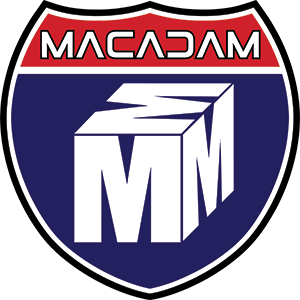Cold planing, also referred to as milling or profiling, removes the top layer of an existing asphalt pavement using a milling machine.
This is often recommended for deteriorated asphalt surfaces to prepare them for resurfacing or overlaying. It restores the smoothness, functionality, and structural integrity of the pavement to help improve its longevity.
This process removes the top layer of asphalt and involves several steps:
- Equipment Setup:
- Milling Machine: A large milling machine equipped with a rotating cutting drum is used for cold planing. The cutting drum contains numerous cutting teeth that remove the asphalt pavement as it moves along the surface. The size and configuration of the cutting teeth can vary depending on the desired milling results.
- Transportation and Support Equipment: The milling machine is usually accompanied by support vehicles, such as trucks to transport the milled material (reclaimed asphalt pavement or RAP) and equipment for dust control.
- Surface Preparation:
- Traffic Control: Proper traffic control measures are put in place to ensure the safety of workers and motorists during the cold planing process. This may involve lane closures, detours, or other temporary traffic arrangements.
- Cleaning: The surface to be cold planed is thoroughly cleaned to remove loose debris, dirt, and vegetation. This allows for better access to the pavement and prevents contaminants from interfering with the milling process.
- Milling Operations:
- Depth and Width Setting: The milling machine operator adjusts the depth and width of the cutting drum based on project specifications. The desired milling depth is determined by the extent of pavement distress and the planned thickness of the overlay or subsequent treatment.
- Milling Passes: The milling machine is driven along the pavement surface, typically moving in a straight line. The cutting drum rotates and the cutting teeth remove the asphalt material. The machine operator maintains a consistent milling depth and speed to achieve uniform results.
- Edge Milling: In some cases, the milling machine may be equipped with a device to mill the edges of the pavement, ensuring a smooth transition between the milled area and the adjacent pavement.
- Controlling Dust: Dust control measures, such as water sprays or vacuum systems, are employed to minimize airborne dust generated during the milling process. This helps maintain good visibility for workers and reduces environmental impacts.
- Removal and Transportation of Milled Material:
- Collection and Loading: The milled material, known as reclaimed asphalt pavement (RAP), is collected using conveyor belts or augers located at the rear of the milling machine. The RAP is then loaded onto trucks for transport to a recycling facility or other designated location.
- Stockpiling: If the RAP is intended for immediate reuse in the project, it may be stockpiled near the milling site for subsequent incorporation into new asphalt mixes.
- Surface Inspection and Cleanup:
- Inspection: After the milling is complete, the milled surface is inspected for any remaining irregularities or areas that may require additional work or repairs. This evaluation ensures that the milled surface is ready for subsequent treatments or overlays.
- Cleanup: Any debris, dust, or loose material resulting from the milling process is removed from the pavement surface. Sweeping or other cleaning methods are employed to ensure a clean and debris-free area.
The cold planing process effectively removes the deteriorated or damaged surface of asphalt pavement, preparing it for further treatments or the application of a new overlay. It provides a key step in pavement rehabilitation and allows for the recycling of the milled material for sustainable construction practices.


